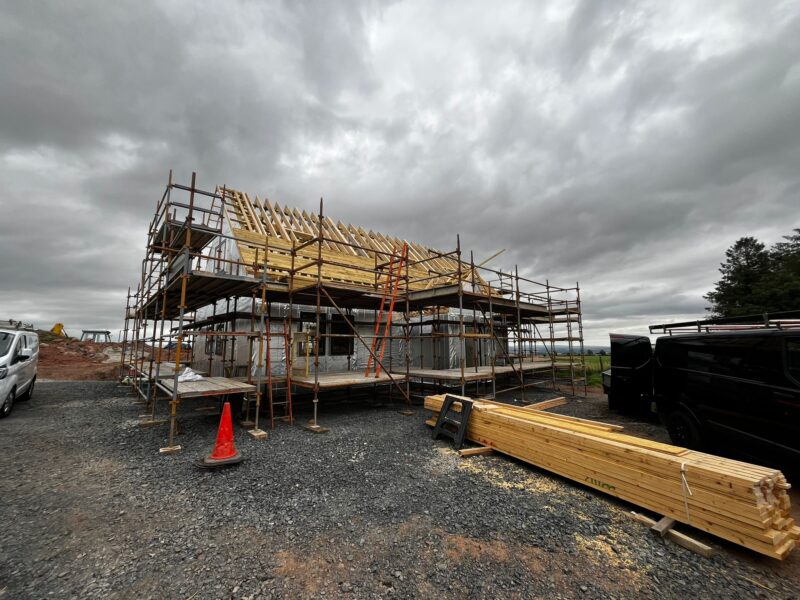
Building your own home is an exciting and rewarding journey. While the preparation phase of the build is not the most glamourous, it is incredibly important to the success of your project. Which is why we asked our Site Preparation Coordinator, David Hutchison, for some advice.
David says:
“One of the most vital, yet often undervalued aspects of self-building is clearly thought-out site preparation and health and safety planning. Abraham Lincoln once said, “Give me six hours to chop down a tree and I will spend the first four sharpening the axe.” A smooth build starts with good preparation and investing your time at this early stage will ultimately make your self-build journey smoother, safer, and much more enjoyable.
Site Access and Deliveries: Think Like a Lorry Driver
Your dream plot may be based in the countryside with beautiful views out over the mountains, but if the access road is more suitable for a mountain goat than an articulated lorry, then you may have a problem. The safe and efficient delivery and movement of materials is fundamental. To avoid unnecessary delays, additional cost and exposing workers to risks, careful planning of site access is essential. Make sure you consider the following points:
- Access for Large Vehicles: Big materials need big vehicles. If you’re receiving deliveries of timber frame panels, roof trusses, external joinery or other bulky materials, ensure there’s adequate space for articulated lorries to manoeuvre. Narrow lanes, sharp turns, or low/weak bridges can cause significant challenges; assess the route well in advance and inform your provider as early in the process as possible about any obstructions or concerns you have. Videos are a great way to do this.
- Delivery Zones: Have you planned for offload and storage? Create a designated space for unloading materials that’s clear of hazards and positioned for easy access to the work area. A solid, flat area will stop heavy materials from sinking on soft parts of your site. This reduces the risk of damage or accidents and helps keep the site organised.
- Clear Communication: Provide delivery drivers and providers with clear instructions, including site maps, photos, videos and information on any specific restrictions, to ensure everything runs smoothly on arrival.
Mechanical Handling: Work Smarter, Not Harder
Heavy lifting is an inevitable feature of self-build projects. However, sometimes the cheapest option is not the best. While cranes might seem costly, they can shave days or even weeks off the time it takes to erect a timber frame. They are also a safer option and, where sites are tight and access is restricted, are simply unavoidable.
- Cranes and Telehandlers: These machines are crucial for moving large items like timber panels, steel or roof trusses into position, especially at height.
- Route Planning: Ensure machinery has clear, unobstructed pathways to move around the site safely. Avoid sharp turns or uneven ground that could compromise stability.
- Training: Anyone operating mechanical handling equipment should be properly trained and competent. So, make sure everyone on your site can prove their competency to you prior to them starting work.
- Budget: Don’t forget to include mechanical handling within your initial project budget. Our advice is to plan for a crane. If you make a saving along the way and can afford that luxury hot tub at the end of the project as a result, then that’s great! But just remember, you can’t hang curtains in a Jacuzzi…

Don’t Skimp on Scaffolding
Falls from height is the single most common cause of injury and fatality on building sites. Scaffolding is required to ensure tasks above ground level can be carried out safely. It’s essential to work with competent and accredited providers to avoid risks.
- Professional Standards: Accredited scaffolders follow industry standards ensuring your scaffolding is secure, stable, and suitable for your project.
- Regular Inspections: Legally, scaffolding should be inspected every seven days or after any large weather events. Adjustments or repairs should only be carried out by accredited professionals. Make sure your scaffolders are willing to come and carry out these checks and keep everything safe.
- Prioritise Safety Over Shortcuts: DIY scaffolding or unqualified contractors may seem like a cost-saving option, but the risks far outweigh the savings. Most reputable contractors, including Fleming Homes, will reserve the right to leave site if the scaffolding is not fit for purpose.
Site Cleanliness: A Safer, More Efficient Build
A clean construction site isn’t just about getting in the new neighbour’s good books, it’s an essential part of the health and safety of your project. Keeping your site tidy reduces the risk of accidents and creates a better working environment.
- Preventing Trips and Falls: Loose materials, offcuts, and debris scattered across the site are among the most common causes of trips and falls. Regularly clearing walkways and work areas helps to minimise these risks.
- Fire Safety: Piles of waste materials, especially timber or product packaging, can quickly become fire hazards. Proper waste management, such as a skip and regular removal of rubbish, significantly reduces this danger.
- Improved Productivity: A tidy site allows workers to find their tools and materials easily, reducing unnecessary downtime and keeping things on schedule.
- Hazard Identification: A clean site makes it easier to spot potential hazards, such as spills, damaged equipment, or trip hazards, so they can be addressed promptly.
By incorporating site cleanliness into your daily routine, you’ll create a safer, more organised project for your contractors to work on, saving time and money on site.”

